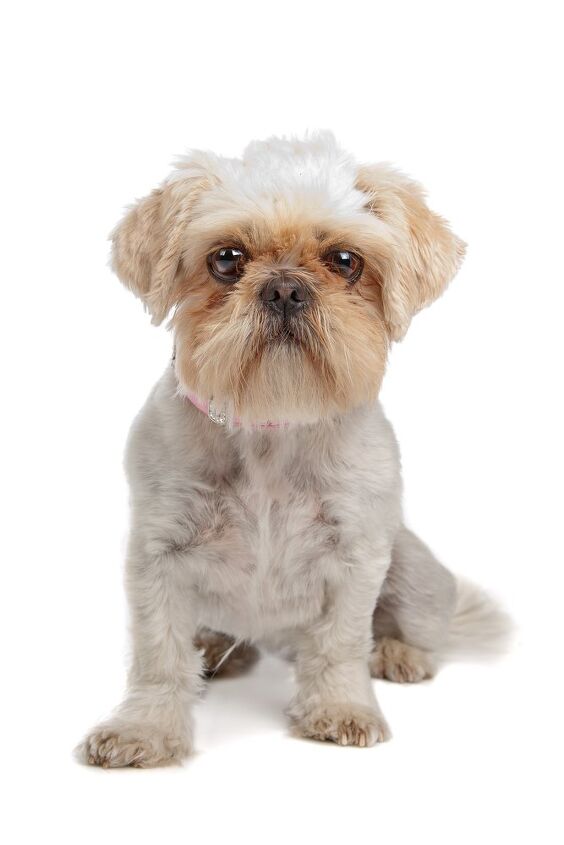Shinese


About Shinese
The Shinese is a loyal and loving dog who brings the headstrong nature of the Shih Tzu together with the protective Pekingese for a feisty little family dog that thrives on human companionship. In spite of his sometime aloof personality he loves spending time with his people and can often suffer from separation anxiety if left on his own for too long.
The loving Shinese brings the headstrong nature of the Shih Tzu together with the protective Pekingese for a fun family pooch.
The Shinese is the offspring of 2 ancient breeds: The Shih Tzu that dates back to the year 800 in Tibet and the Pekingese (aka the Lion Dog) which is considered one of the oldest dog breeds around and which was bred over a thousand years ago for Chinese aristocracy. Today’s Shinese is far less dated, going back only 30 to 40 years to when breeders first started to cross different breeds in a bid to cancel out the health issues that plagued the pure-bred parents. These designer dogs were also often bred to be a smaller, gentler or even hypo-allergenic variation on a popular breed.
As he comes from 2 different purebreds, the Shinese doesn’t qualify to be a member of the American Kennel Club (AKC) however both of his parent breeds are members. The Pekingese joined the “toy” group in 1906 while the Shih Tzu was named to the same group in 1969.
The Shinese requires a top-quality kibble designed specifically to meet his age, size and activity levels. Because he is prone to gaining weight and can experience joint issues later in life, it’s important he maintain a health weight. To do this, plan to feed him 2 to 3 smaller meals each day rather than free-feeding and always opt for a food and treat that is low in fillers (carbs) that will cause him to want to eat more to feel full. Because of his flatter face, you should consider purchasing a feeding dish specifically designed for this type of dog – less mess and a cleaner face!
The Shinese comes from two head-strong breeds, and because the Shih Tzu is known to be a challenge when it comes to house-breaking, training needs to start when he is young, will require lots of patience and may even need you to bring in a professional to get the results you want. Take a firm, consistent approach that establishes pack leadership. Rewards including verbal praise, pats and treats for a job well done will go a long way in netting results.
When he reaches adulthood, the Shinese will weigh between 12 to 16 pounds.
This independent little dog is the offspring of two intelligent and often stubborn breeds. While he loves his family and being the center of attention, he will need early socialization to ensure he doesn’t become territorial and snappish when strangers or new dogs approach. He is great with kids and other pets and while he isn’t considered yappy, he is quick to alert to strangers, making him a great watchdog. His need for human attention means he can suffer from separation anxiety if left on his own for long periods of time.
The Shinese is a healthy little dog who has no known health issues however it’s always important to know what your new pup could one day inherit. With the Shinese, that can include respiratory issues due to the flatter face, joint issues including patellar luxation and eye conditions.
The Shinese has a life expectancy of between 12 and 15 years.
The Shinese is an active little dog that loves interactive playtime but he doesn’t need a great deal of exercise. Regular short daily walks should be sufficient to keep him physically fit. Visits to an off-leash park are also an excellent way to vary up his exercise regimen and also help him with socialization and learning to play nice with others.
In spite of the Shinese independent nature, he thrives on human attention.
Also known as the Peke-A-Tzu, the Peke-Tzu and the Shih-teze, the Shinese has a mixed breed status that precludes him from joining the American Kennel Club (AKC), however he is recognized by the American Canine Hybrid Club (ACHC), the Designer Breed Registry (DBR), the Designer Dogs Kennel Club (DDKC), the Dog Registry of America, Inc. (DRA). And the International Designer Canine Registry (IDCR).
Your Shinese’s long, thick, double-coat will require daily brushing to prevent matting and tangling as well as regular visits to the groomers to keep it trim and looking its best. While he isn’t a heavy shedder, he does shed and brushing will help keep that in check. Whenever grooming, make a point of inspecting and cleaning ears and any skin folds around his face to prevent irritation and injury. Because small dogs can be prone to periodontal disease, use this time to also brush his teeth.
A stubborn pup can grow into a stubborn dog which means the Shinese requires socialization and obedience training from a very early age. Because he can be prone to joint issues when he’s older, be sure to supervise handling of this pup and to not over-exert when playing to avoid injuring tiny limbs.
Photo credit: Erik Lam/Shutterstock; ACButterfly Photography/Shutterstock

Sharing space with three seriously judgy Schnoodles and a feline who prefers to be left alone. #LivingMyBestLife
More by Mary Simpson
























